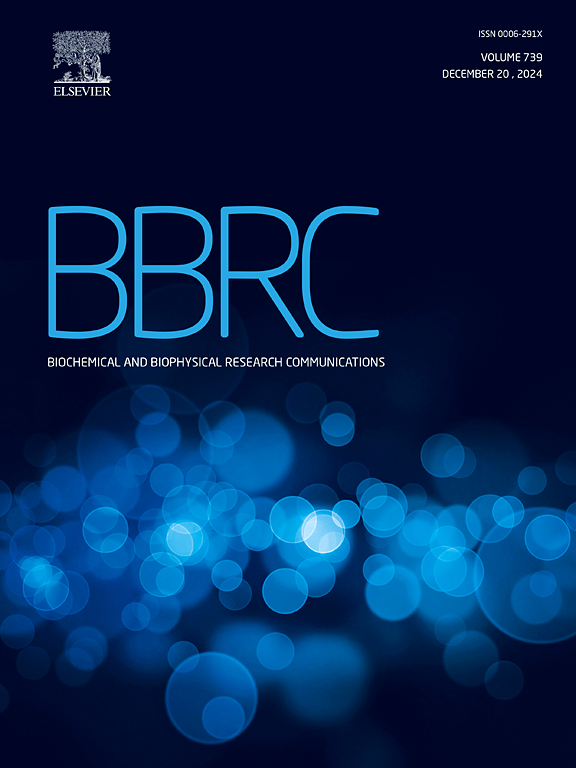植物与动物蛋白包盖银纳米粒子在生物系统中的比较研究
IF 2.2
3区 生物学
Q3 BIOCHEMISTRY & MOLECULAR BIOLOGY
Biochemical and biophysical research communications
Pub Date : 2025-05-12
DOI:10.1016/j.bbrc.2025.152005
引用次数: 0
摘要
本研究提出了一种生态友好的方法来合成纳米银(AgNPs),利用从动物和植物中提取的蛋白胨的自然还原和稳定能力,然后对其进行深入的物理化学表征,并对其抗氧化、酶和毒理学特性进行全面评估。利用先进的技术对纳米颗粒(NPs)进行了结构分析,包括透射电子显微镜(TEM)、能量色散x射线光谱(EDS)、动态光散射(DLS)、傅里叶变换红外光谱(FT-IR)和紫外可见光谱(UV-vis)。合成的AgNPs经颜色变化证实为球形,尺寸分别为32.20 nm(动物蛋白胨)和48.73 nm(植物蛋白胨)。生物学评价显示出剂量依赖性的抗氧化和酶抑制活性,动物源性AgNPs在1000 μg mL−1时表现出较好的抗氧化活性,抗α-淀粉酶活性为83.40%,抑制α-淀粉酶活性为73.06%,抑制脲酶活性为51.65%。小鼠急性毒性试验显示,口服或腹腔注射2mg mL−1超过14天无不良反应。总的来说,使用动物和植物来源的蛋白胨提供了传统化学方法的环保替代方案,促进了绿色化学的发展。这些发现突出了肽源AgNPs作为有效抗氧化剂和酶抑制剂的潜力,在生物医学领域具有广阔的应用前景。本文章由计算机程序翻译,如有差异,请以英文原文为准。

A comparative study of the plant and animal peptone-capped silver nanoparticles on biological systems
This study presents an eco-friendly approach for synthesizing silver nanoparticles (AgNPs) by using the natural reducing and stabilizing capabilities of peptones extracted from both animal and plant sources, followed by an in-depth physicochemical characterization and a thorough assessment of their antioxidant, enzymatic, and toxicological properties. Advanced techniques were utilized for structural analysis of the nanoparticles (NPs), including transmission electron microscopy (TEM), energy-dispersive X-ray spectroscopy (EDS), dynamic light scattering (DLS), Fourier-transform infrared spectroscopy (FT-IR), and UV–visible (UV–vis) spectroscopy. The synthesized AgNPs were confirmed by a color change and characterized as spherical, with sizes of 32.20 nm (animal peptones) and 48.73 nm (plant peptones). Biological evaluation showed dose-dependent antioxidant and enzyme inhibitory activities, with animal-derived AgNPs exhibiting superior effects—83.40 % antioxidant activity, 73.06 % α-amylase inhibition, and 51.65 % urease inhibition at 1000 μg mL−1. Acute toxicity tests in mice revealed no adverse effects at 2 mg mL−1 via oral or intraperitoneal administration over 14 days. Overall, using peptones from animal and plant sources provides an environmentally friendly alternative to conventional chemical methods, promoting green chemistry approaches. These findings highlight the potential of peptone-derived AgNPs as effective antioxidants and enzyme inhibitors, suggesting promising applications in biomedical fields.
求助全文
通过发布文献求助,成功后即可免费获取论文全文。
去求助
来源期刊
CiteScore
6.10
自引率
0.00%
发文量
1400
审稿时长
14 days
期刊介绍:
Biochemical and Biophysical Research Communications is the premier international journal devoted to the very rapid dissemination of timely and significant experimental results in diverse fields of biological research. The development of the "Breakthroughs and Views" section brings the minireview format to the journal, and issues often contain collections of special interest manuscripts. BBRC is published weekly (52 issues/year).Research Areas now include: Biochemistry; biophysics; cell biology; developmental biology; immunology
; molecular biology; neurobiology; plant biology and proteomics

 求助内容:
求助内容: 应助结果提醒方式:
应助结果提醒方式:


